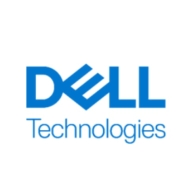![Cisco HyperFlex HX-Series [EOL] Logo](https://images.peerspot.com/image/upload/c_scale,dpr_3.0,f_auto,q_100,w_64/0dra2w8zbx5vrvwmhkdswx9l90ys.jpg)

Cisco HyperFlex HX-Series and VxRail compete in the hyper-converged infrastructure category. VxRail tends to have the upper hand due to its comprehensive VMware integration and automation features.
Features: Cisco HyperFlex is praised for integrating computing, storage, and networking into a single device, leading to cost savings and ease of deployment. It is valued for its flexibility, scalability, and robust integration capabilities. VxRail is noted for its deep integration with VMware, providing high performance, automation, and a unified management interface. Users find VxRail's single pane of glass management and simplified upgrades highly beneficial.
Room for Improvement: Cisco HyperFlex users desire better integration with other technologies, enhanced pricing models, and improvements in management tools. Additionally, they seek better documentation and flexibility in upgrading server components individually. VxRail needs better integration with other cloud services and a streamlined upgrade process. More customization options and better pricing for smaller deployments are also suggested.
Ease of Deployment and Customer Service: Cisco HyperFlex and VxRail are primarily deployed on-premises, with VxRail also used in hybrid cloud environments. Cisco HyperFlex users appreciate the customer service but note opportunities for technical support improvement. VxRail is praised for its technical support, though there's a demand for simpler deployment and more straightforward support paths.
Pricing and ROI: Cisco HyperFlex is seen as expensive, though it offers ROI through administration cost savings and reduced downtime. VxRail is also perceived as costly but is viewed as a better long-term investment for larger enterprises due to its comprehensive support, bundled licensing, and reduced operational costs. Both solutions provide significant ROI, but VxRail often delivers better value through its VMware integration benefits.


| Company Size | Count |
|---|---|
| Small Business | 24 |
| Midsize Enterprise | 17 |
| Large Enterprise | 57 |
| Company Size | Count |
|---|---|
| Small Business | 41 |
| Midsize Enterprise | 42 |
| Large Enterprise | 56 |
The Cisco HyperFlex HX Data Platform is a purpose-built, high-performance, scale-out file system with a wide array of enterprise-class data management services. The data platform’s innovations redefine distributed storage technology, giving you complete hyper-convergence with enterprise storage features:
VxRail is a hyper-converged infrastructure appliance co-engineered by Dell Technologies and VMware, designed to optimize VMware environments by simplifying compute, storage, virtualization, and management.
Built on VMware vSAN software, VxRail ensures high performance, reliability, and flexibility. It supports a broad array of workloads, from business-critical applications to next-generation use cases. VxRail simplifies infrastructure management with powerful integration and seamless scalability, offering centralized management and user-friendly interfaces. Streamlined updates, robust lifecycle management, and one-click upgrades facilitate a user-centric experience that minimizes deployment complexity and staffing needs. However, its performance with disk deduplication, integration with public clouds, and processor support can be enhanced, along with pricing and licensing improvements.
What features define VxRail?Organizations across sectors such as finance, telecommunications, education, and manufacturing utilize VxRail for its scalability, ease of deployment, and infrastructure management capabilities. It aids in server and application hosting, storage, and virtualization management, often employing VMware integration. The platform is valued for its ability to consolidate IT components, support VDI solutions, and enhance cloud readiness and resource allocation.
We monitor all HCI reviews to prevent fraudulent reviews and keep review quality high. We do not post reviews by company employees or direct competitors. We validate each review for authenticity via cross-reference with LinkedIn, and personal follow-up with the reviewer when necessary.